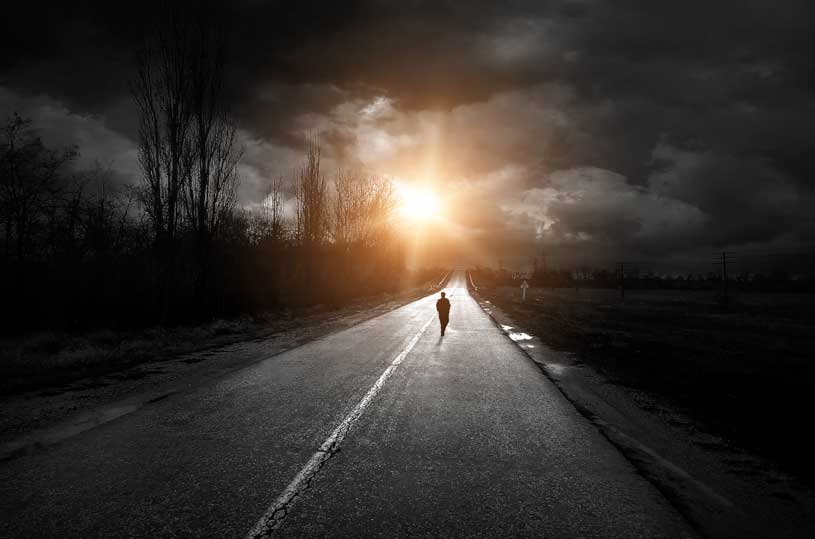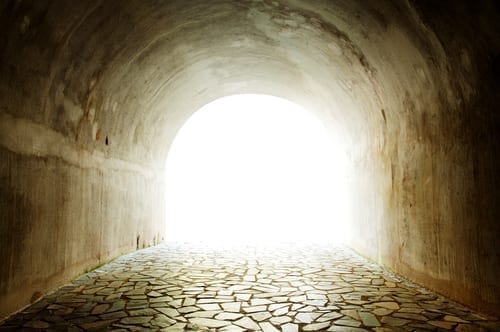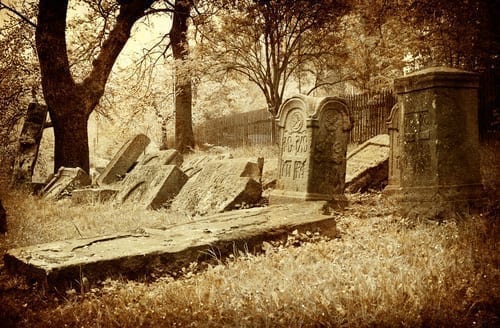The scientific definition of death is a combination of several elements: A cessation of heart activity; loss of brain function – meaning, no measurable brainwaves; cessation of oxygen flow to the brain cells; a drop in body temperature; and cessation of operation of the senses. According to a major Gallup poll in the United States in 1997, at least thirteen million Americans have returned to life after being deemed clinically dead. It is estimated that in the entire world, the number of people who have returned to life after clinical death is about thirty million! Most amazing is the fact that the majority of these people describe similar experiences from the time of their “death.” Some of them even describe what took place around their bodies during their period of clinical death.
Here are some accounts proving the truths inherent in these phenomena: “Above me was a light that was clearer than anything I had ever seen. Afterwards a form appeared before me and communicated to me without words, instructing me to look downward. There I saw a ball about the size of a tennis ball rotating slowly in space. I knew that I had to go back there. When I moved in its direction it began to get bigger and bigger. I didn’t want to go back there. I wanted to stay where I was – in space, continuing to go forward. Today I understand that I was looking at the earth. I saw it in all of its color. This was long before there were pictures of the earth from outer space.”
The proceeding description was taken from the authentic testimony of J. Fried, a retired police captain, as documented in a video Visions of Hope – The Near Death Experience, released in England. The video presents the testimony of people who have experienced a near-death experience, after entering a state of clinical death, in which the heart has ceased to pump while the brain continues to function.
According to his testimony, Fried’s story began on a Friday afternoon, when the doctor called to his bedside could do nothing more but pronounce him dead and notify his family of the terrible news. “My father told me that they were supposed to take me to the hospital to perform an autopsy, but my mother, being a religious Jew, would not let them do so before the end of the Sabbath. On Sunday morning I ‘woke up’ and started making noises, which really startled the person standing by my body,” Fried recalls.
Fried’s account – coming as it does from a reliable, honest individual – is one of scores of testimonies documented by the video. The immense impact of this experience on Fried’s life is summarized by one sentence: ‘I know that this is not the final station [in life].’ Trudy Leese, another witness returning from clinical death, capsulated her experience in these words: ‘Now I know without any doubt that I am not this body.’
~ Testimonies, from Dr. Raymond Moody’s book Life after Life~~
“I got up and walked into the hall to go get a drink, and it was at that point, as they found out later, that my appendix ruptured. I became very weak, and I fell down. I began to feel a sort of drifting, a movement of my real being in and out of my body, and to hear beautiful music. I floated on down the hall and out the door onto the screened-in porch. There, it almost seemed that clouds, a pink mist really, began to gather around me, and then I floated right straight on through the screen, just as through it weren’t there, and up into this pure crystal clear light, an illuminating white light. It was beautiful and so bright, so radiant, but it didn’t hurt my eyes. It’s not any kind of light you can describe on earth. I didn’t actually see a person in this light, and yet it has a special identity, it definitely does. It is a light of perfect understanding and perfect love.”
Another testimony:
“I knew I was dying and that there was nothing I could do about it, because no one could hear me… I was out of my body, there’s no doubt about it, because I could see my own body there on the operating room table. My soul was out! All this made me feel very bad at first, but then, this really bright light came. It did seem that it was a little dim at first, but then it was this huge beam. It was just a tremendous amount of light, nothing like a big bright flash-light, it was just too much light. And it gave off heat to me; I felt a warm sensation.
It was a bright yellowish white – more white. It was tremendously bright; I just can’t describe it. It seemed that it covered everything, yet it didn’t prevent me from seeing everything around me – the operating room, the doctors and nurses, everything. I could see clearly, and it wasn’t blinding.
At first, when the light came, I wasn’t sure what was happening, but then, it asked, it kind of asked me if I was ready to die. It was like talking to a person, but a person wasn’t there. The light’s what was talking to me, but in a voice.”
Dr. Moody also records cases in which individuals experience a review of their entire lives:
“When the light appeared, the first thing he said to me was 'What do you have to show me that you’ve done with your life?' or something to this effect. And that’s when these flashbacks started. I thought, 'Gee, what is going on?' because, all of a sudden, I was back early in my childhood. And from then on, it was like I was walking from the time of my very early life, on through each year of my life, right up to the present… The things that flashed back came in the order of my life, and they were so vivid. The scenes were just like you walked outside and saw them, completely three-dimensional, and in color. And they moved.”
In other cases, doctors and others were amazed by the reports of events that the individuals witnessed when they were outside of their bodies. For example, one young woman, on the verge of death, traveled out of her body to another room in the hospital. She found her sister weeping, pleading: “Please, Katie, don’t die!”. Her sister was amazed when Katie later told her exactly when and what she had said in that room.
In another section of his book, Dr. Moody explains how a person’s sense of his new “spiritual” body after “death” is both similar and different from the sense of his physical body in this world. In certain ways, the spiritual body is more limited. Dr. Moody notes that the sensation of movement (kinesthesia) is lost. In a few cases, individuals did not report any sense of warmth, although in the majority of cases, a pleasant feeling of warmth was reported. No individuals ever described a sense of smell or taste during the time they are removed from the physical body. On the other hand, the senses of sight and hearing seem much more developed than in a normal physical state. One man told Dr. Moody that during the time that he was “dead” his vision was unbelievably sharp. In this witness’s words: “I just can’t understand how I could see so far.” A woman who “returned” had this to add: “It seemed as if this spiritual sense had no limitations, as if I could look anywhere and everywhere.” This phenomenon is well described in an interview with a woman who left her body as the result of an accident:
“There was a lot of action going on, and people running around the ambulance. And whenever I would look at a person to wonder what they were thinking, it was like a zoom-up, exactly like through a zoom lens, and I was there. But it seemed that part of me – I’ll call it my mind – was still where I had been, several yards away from my body. When I wanted to see someone at a distance, it seemed like part of me, kind of like a tracer, would go to that person. And it seemed to me at the time that if something happened anyplace in the world that I could just be there.”
On the other hand, “hearing” in an out-of-body state is at best a mere analogy to normal hearing. Most people say that they did not actually hear voices or physical sounds. More appropriately described, these people received communication from people around them through some kind of telepathy. This plays an extremely important part in the latter stages of the out-of-body experience. One woman makes this point very clear:
“I could see people all around, and I could understand what they were saying. I didn’t hear them, audibly, like I’m hearing you. It was more like knowing what they were thinking, exactly what they were thinking, but only in my mind, not in their actual vocabulary. I would catch it the second before they opened their mouths to speak.”
And in the end, according to one important and unique account, even extreme physical damage does not affect their spiritual body. In this particular instance, a man lost most of his leg in an accident, causing him to enter a state of clinical death. He knew this because he saw his injured body clearly from afar, while the doctors attended to him. Yet at the same time as he was outside of his body, he said:
“I could feel my body, and it was whole. I know that. I felt whole, and I felt that all of me was there, although it wasn’t.
In conclusion, we must emphasize that there in no reason to assume that these accounts know about or cover every aspect of the after-death experience. Nor is there any way of even guessing what else might have occurred to the individuals above, which God wanted them to forget. Furthermore, the people in these cases did not actually die, and there is no way of knowing from their testimonies the process of death for people who do not return to this world. It is also important to note that most of the cases above describe the experiences of non-Jews. This leaves open the question of whether differences exist between Jewish and non-Jewish near-death experiences, based upon their different obligations in life: Jews are obligated to fulfill 613 biblical commandments, whereas non-Jews are obligated in only seven. Therefore, we must limit the conclusions drawn from these reports to the general recognition that the true “I” is the spiritual person, and that there is undoubtedly life after death.




